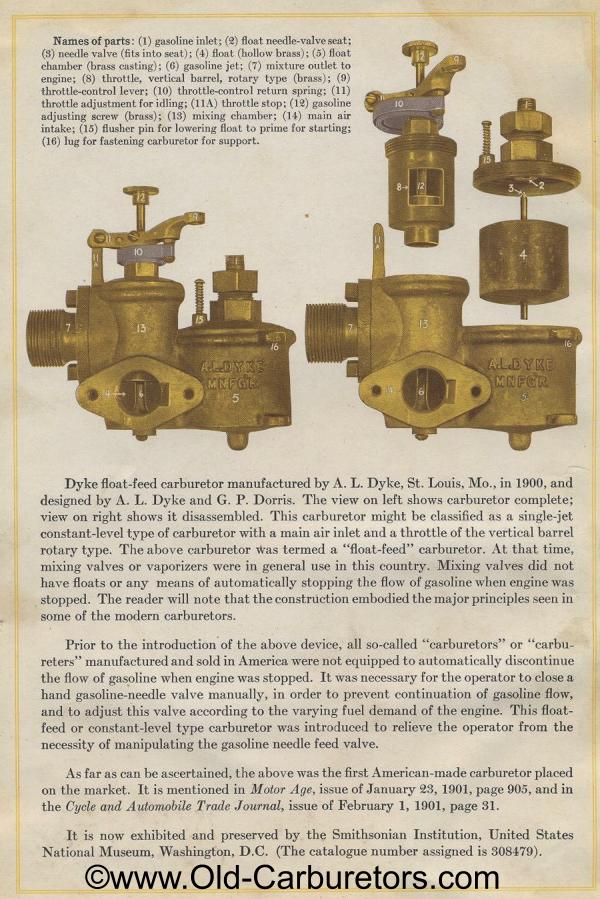Dyke float-feed carburetor
Names of parts: (1) gasoline inlet; (2) float needle-valve seat;
(3) needle valve (fits into seat); (4) float (hollow brass); (5)
float chamber (brass casting); (6) gasoline jet; (7) mixture outlet
to engine; (8) throttle, vertical barrel, rotary type (brass);
(9) throttle-control lever; (10) throttle-control return spring;
(11) throttle adjustment for idling; (11A) throttle stop; (12)
gasoline adjusting screw (brass); (13) mixing chamber; (14) main
air intake; (15) flusher pin for lowering float to prime for starting;
(16) lug for fastening carburetor for support.
Dyke float-feed carburetor manufactured by A. L. Dyke, St. Louis,
Mo., in 1900, and designed by A. L. Dyke and G. P. Dorris. The
view on left shows carburetor complete; view on right shows it
disassembled. This carburetor might be classified as a single-jet
constant-level type of carburetor with a main air inlet and a throttle
of the vertical barrel rotary type. The above carburetor was termed
a "float-feed" carburetor. At that time, mixing valves
or vaporizers were in general use in this country. Mixing valves
did not have floats or any means of automatically stopping the
flow of gasoline when engine was stopped. The reader will note
that the construction embodied the major principles seen in some
of the modern carburetors.
Prior to the introduction of the above device, all so-called "carburetors" or "carbureters" manufactured
and sold in America were not equipped to automatically discontinue
the flow of gasoline when engine was stopped. It was necessary
for the operator to close a hand gasoline-needle valve manually,
in order to prevent continuation of gasoline flow, and to adjust
this valve according to the varying fuel demand of the engine.
This float-feed or constant-level type carburetor was introduced
to relieve the operator from the necessity of manipulating the
gasoline needle feed valve.
As far as can be ascertained, the above was the first American-made
carburetor placed on the market. It is mentioned in Motor Age,
issue of January 23, 1901, page 905, and in the Cycle and Automobile
Trade Journal, issue of February 1, 1901, page 31.
It is now exhibited and preserved by the Smithsonian Institution,
United States National Museum, Washington, D.C. (The catalogue
number assigned is 308479).
Previous page 1927
Supplement Home Next page 
|
